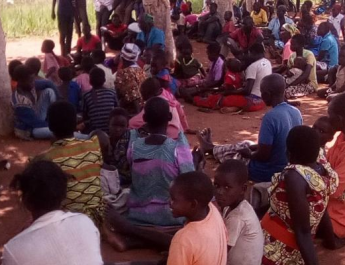Communities in Teso sub-region have employed local methods to chase desert locusts from their villages.
In sub-counties of Gweri, Kamuda and Soroti, a number of residents are seen screaming, drumming, blowing whistles, sounding pans and throwing stones to chase away the migratory pests which invaded the area more than a week ago.
In urban settings like Pamba in Western Division of Soroti Municipality, residents played loud music as motorcycles hooted to ensure that the swarm flying over their roofs did not land in any neighbouring bushes or gardens. Locusts eat everything gree, destroying the crops and pasture wherever they go.
Desert Locusts, according to scientists, are sensitive to sound and movement. This scares them away, in most cases making their settlement in a particular area difficult. Gerald Omoit, a resident in Gweri Sub County says they had no choice but to make noise for the locusts to continue flying.
“We are told that whenever those insects land in an area, they cause devastating effects. We wouldn’t want to wait for them to eat our crops. That is why we joined hands in the village to chase them away”, he said.
Daniel Toroitich, an elder from Katikekile sub-county in Moroto district, says that in the 60s when locusts last invaded Uganda, elders were advised to make noise to chase away the voracious insects, a method which he says was not very effective.
But the approach by residents has been condemned by officials in the ministry of Agriculture, Animal Industry and Fisheries. State Minister for Agriculture, Aggrey Bagiire says the approach will make the insects spread to different places faster than they should have moved.
Dr Patience Rwamigisa, the Commissioner for Agriculture Extension Services says chasing away locusts makes their control operations on the insects very difficult.
Desert Locusts have spread almost to all districts in Karamoja and Teso sub-regions since their invasion on February 9, through Amudat and Moroto.
According to scientists, extreme weather patterns in the Indian Ocean, caused by climate change, created the perfect conditions for locusts to breed and spread from Yemen to East Africa. They have so far been reported in Kenya, Somalia, Ethiopia and Sudan among other countries where they have devastated plantations and left communities in sire need.
Latest predictions by the Food and Agricultural Organisation show that the locust infestation in East Africa could drive more than 13 million people deeper into a hunger crisis and increase the risk that more children will die from malnutrition.
The government on Saturday received a plane that will be used to
aid the aerial spray of locusts in different parts of the country.

The News Editor ,Reporter at Kagadi Kibaale community Radio




